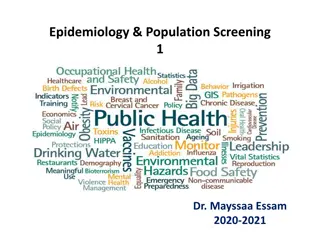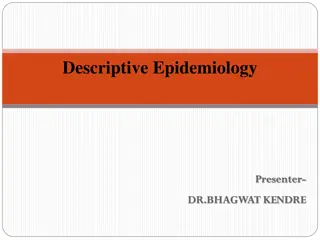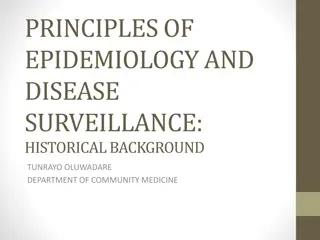Understanding Disease Patterns in Epidemiology: Overview and Examples
Epidemiology is the study of health event distribution in populations. This includes analyzing disease patterns by time, place, and affected individuals. Diseases can be sporadic, endemic, epidemic, or pandemic, each with distinct occurrence characteristics. Understanding disease prevalence and incidence helps in evaluating the burden of illnesses on populations.
Download Presentation

Please find below an Image/Link to download the presentation.
The content on the website is provided AS IS for your information and personal use only. It may not be sold, licensed, or shared on other websites without obtaining consent from the author. Download presentation by click this link. If you encounter any issues during the download, it is possible that the publisher has removed the file from their server.
E N D
Presentation Transcript
Estimate & pattern of diseases Unit-1 By- Dr. Sonam Bhatt Assistant Professor VMD BASU PATNA
Part of epidemiology It is the study and analysis of the distribution (who, when, and where), patterns & determinants of health & disease conditions in defined populations It is concerned with the frequency and pattern of health events in a population Measures of disease frequency are used to describe how common an illness (or other health event) is with reference to the size of the population (the population at risk) & a measure of time
Pattern refers to the occurrence of health-related events by time, place, and animal When a disease occurrence described in terms of clustering in place, time, then the disease occurs in following patterns: a) b) Endemic c) Epidemic d) Pandemic Sporadic
Sporadic: When a disease appears only rarely or occasionally individuals of a given population Disease occur irregularly or haphazardly Endemic: Disease which are indigenous to or normally present among the population of an area Constant presence of disease or infectious agent in a population within a given geographic area or population group Also refer to the usual or expected frequency of the disease
Outbreak carries the same definition of epidemic, but is often used for a more limited geographic area Epidemic: Disease is said to be an epidemic if its frequency in a given population during a given time interval is clearly in excess of its expected frequency. Pandemic: Epidemic that has spread over several countries or continents, usually affecting a large population
Estimate of disease Prevalence: It measures the number of cases (new + old cases) in a P= No. of existing cases of disease(new + old) Total population at risk population who have the disease at a given point/period of time Point prevalence/ Period prevalence
Incidence: Itis the number of new cases that occur in a known population over a specified period of time. Two essential components of an incidence value are: 1 . the number of new cases 2. the period of time over which the new cases occur Incidence rate: Measures the rapidity with which new cases of disease develop over time I = No. of new cases of disease that occur population during a particular period of time Total population at risk during same time interval
Mortality rate M = number of deaths due to a disease that occur in a population during a particular period of time Total population Death rate: it is the total mortality rate for all diseases Case fatality (CF) = Number of deaths Number of diseased animals

























